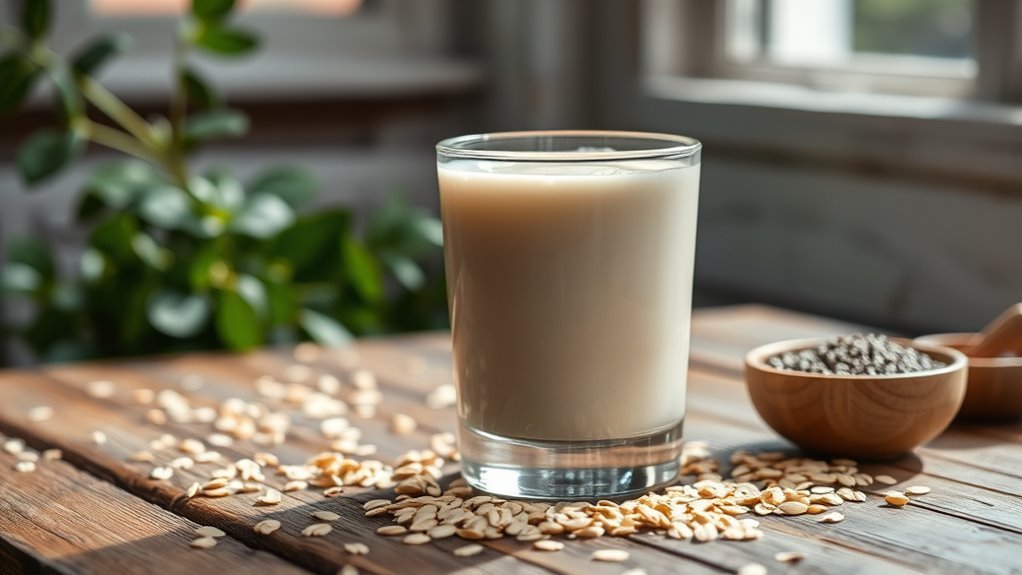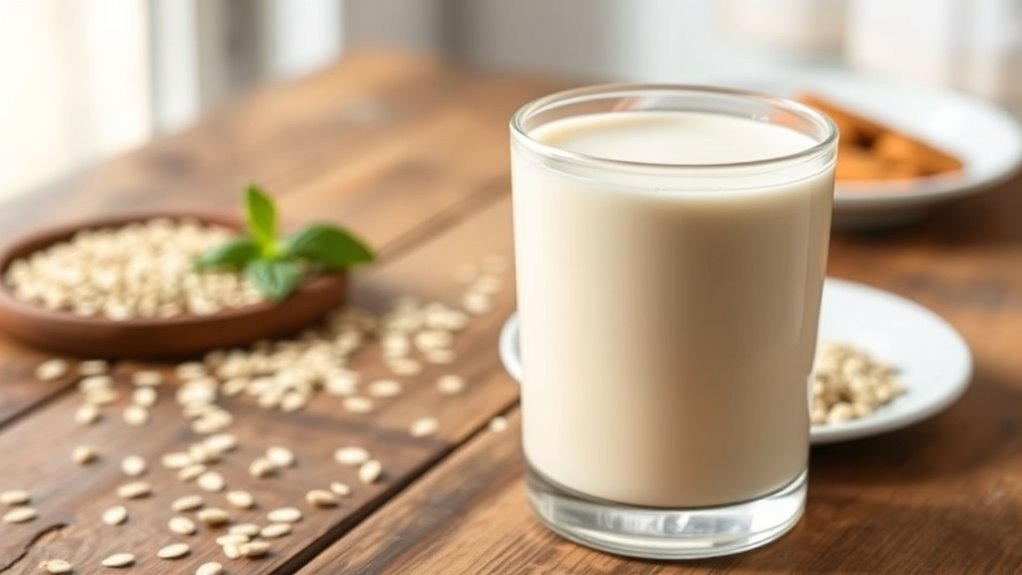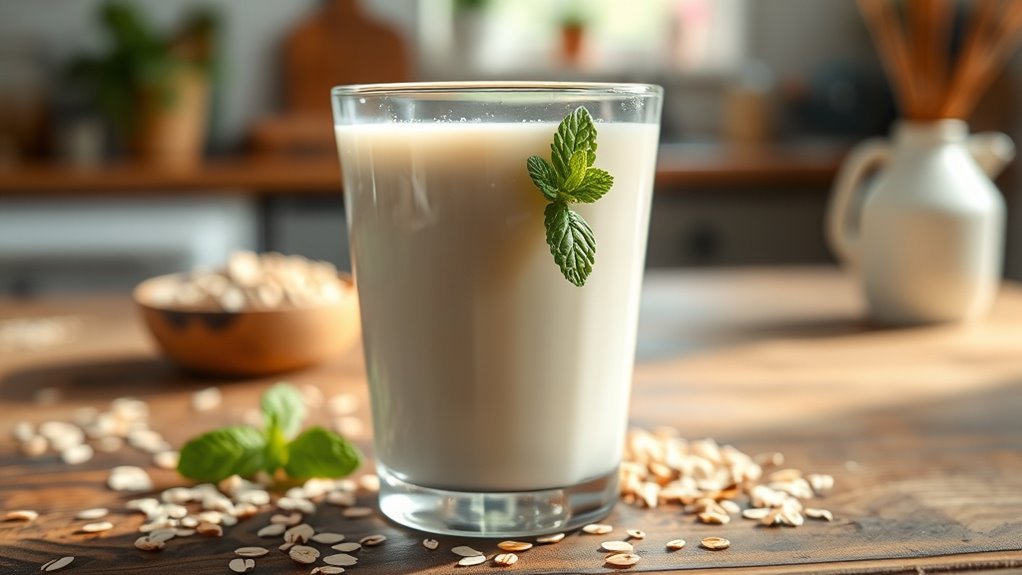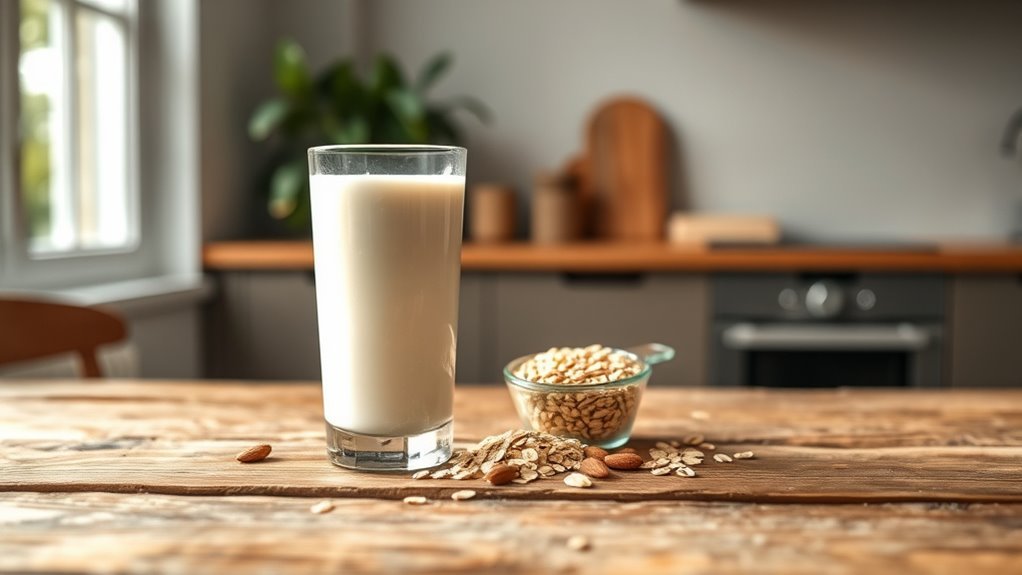Oat milk isn’t typically considered keto-friendly due to its higher carbohydrate content, which averages around 16 grams per cup. This can make it challenging to stay within the daily carb limit of 20-50 grams for a ketogenic diet. While it’s rich in fiber and vitamins, options like almond or coconut milk may be better alternatives. If you’re curious about how to incorporate oat milk into a low-carb lifestyle or explore more milk alternatives, there’s plenty to discover.
Nutritional Profile of Oat Milk

When evaluating oat milk as a dairy alternative, understanding its nutritional profile is key. Oat milk offers several benefits, including being a source of dietary fiber, which can aid digestion and promote heart health. It’s also typically fortified with vitamins and minerals like calcium and vitamin D, enhancing its nutritional value. However, there are drawbacks to evaluate. Oat milk tends to be higher in carbohydrates compared to other non-dairy options, which might not align with everyone’s dietary goals. Additionally, some brands contain added sugars, impacting caloric content. Balancing these oat milk benefits and drawbacks can help you make informed choices, ensuring that your dietary preferences align with your health needs and lifestyle.
Carbohydrate Content and Its Impact on Keto

Although oat milk can be a nutritious option, its carbohydrate content poses challenges for those following a ketogenic diet. With about 16 grams of carbohydrates per cup, oat milk carbohydrates can quickly add up, making it difficult to stay within the typical daily limit of 20-50 grams for a keto diet. This high carb level may hinder your ability to reach or maintain ketosis, the metabolic state essential for burning fat for fuel. If you’re committed to a keto lifestyle, you might want to reflect on alternatives like almond or coconut milk, which have considerably lower carbohydrate counts. Ultimately, it’s vital to assess your choices and how they align with your dietary goals while enjoying the freedom of food exploration.
Understanding Ketosis and Its Requirements

Ketosis is a metabolic state that typically requires a significant reduction in carbohydrate intake, usually below 20-50 grams per day. Achieving this state can lead to various benefits, such as weight loss and increased mental clarity. However, it also comes with some drawbacks, like nutrient deficiencies and potential fatigue during the initial adjustment phase.
| Benefits of Ketosis | Drawbacks of Ketosis | Considerations |
|---|---|---|
| Weight loss | Nutrient deficiencies | Monitor your health |
| Enhanced mental focus | Possible fatigue | Customize your diet |
| Reduced hunger cravings | Social limitations | Stay hydrated and balanced |
Understanding these aspects can empower you to make informed decisions about your dietary choices.
Comparing Oat Milk With Other Milk Alternatives
While you might be drawn to oat milk for its creamy texture and mild flavor, it’s important to compare it with other milk alternatives to understand its nutritional profile and how it fits into your dietary needs. Oat milk benefits include being naturally rich in fiber and vitamins, making it a popular choice. However, it tends to be higher in carbohydrates compared to almond or coconut milk, which are often lower in calories and carbs. Soy milk provides a good protein source, while cashew milk offers a creaminess similar to oat milk but with fewer calories. Ultimately, the best milk alternative for you depends on your dietary preferences and goals, so consider your options carefully to enjoy the freedom of choice in your diet.
How to Incorporate Oat Milk in a Low-Carb Diet
When you’re following a low-carb diet, incorporating oat milk requires a bit of strategy due to its higher carbohydrate content. To enjoy oat milk without derailing your goals, consider using it sparingly in recipes. For instance, try creating low-carb beverages by mixing a splash of oat milk with unsweetened cocoa or coffee. You can also use it in smoothies, blending it with low-carb fruits like berries for a nutritious drink. Additionally, explore oat milk recipes that replace traditional dairy while keeping carbs in check, such as creamy soups or sauces. By balancing your portions and pairing oat milk with low-carb ingredients, you can savor its creamy texture while maintaining your dietary freedom.
Recommended Keto-Friendly Milk Alternatives
If you’re looking for keto-friendly milk alternatives, several options can seamlessly fit into your low-carb lifestyle. Almond milk is a popular choice, as it typically contains just 1-2 grams of carbs per cup, making it a versatile option for smoothies, coffee, or cooking. Just be sure to choose unsweetened varieties to avoid added sugars. Coconut milk is another excellent alternative, offering a creamy texture with around 2-6 grams of carbs per cup, depending on the brand. It’s also rich in healthy fats, which can help you stay satisfied. Both almond and coconut milk can easily replace traditional dairy in your recipes, giving you the freedom to enjoy your favorite meals while sticking to your keto goals.


